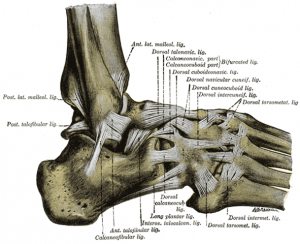One of the first patients I ever treated as a newly-minted physio was a lovely old bloke with a decidedly unlovely ankle sprain. The ankle, courtesy of a slip on wet cement, was gothic horror movie purple, blue and black and about four times the size of its uninjured companion. The injury itself was only minor – what we refer to as a Grade 1 sprain (minor tissue damage to the ligament but no change in its length or function when stressed) – but its little shop of horrors appearance was due to the patient being on blood thinners for a heart condition.
Risk Factors/Causes
The most common ankle sprain is the plantar flexion-inversion sprain aka rolling over on the outside of the ankle. As per my patient this typically occurs on unstable or uneven surfaces or with landing or jumping onto an awkwardly positioned foot. The sprain is either a Grade 1 (as above); a moderate Grade 2 – damage of more fibres with a concomitant increase in ligament stretch or laxity; or Grade 3, a complete rupture. The bad news – if you’ve had one you’re at greater risk for having another. The good news – work on your balance, reaction timing and proprioception and you’re well on the way to avoiding a repeat performance.
Management
Think you’ve sprained your ankle or need help with your post-injury rehab come and see one of our highly qualified physios today [ Click here to Request an Appointment ]